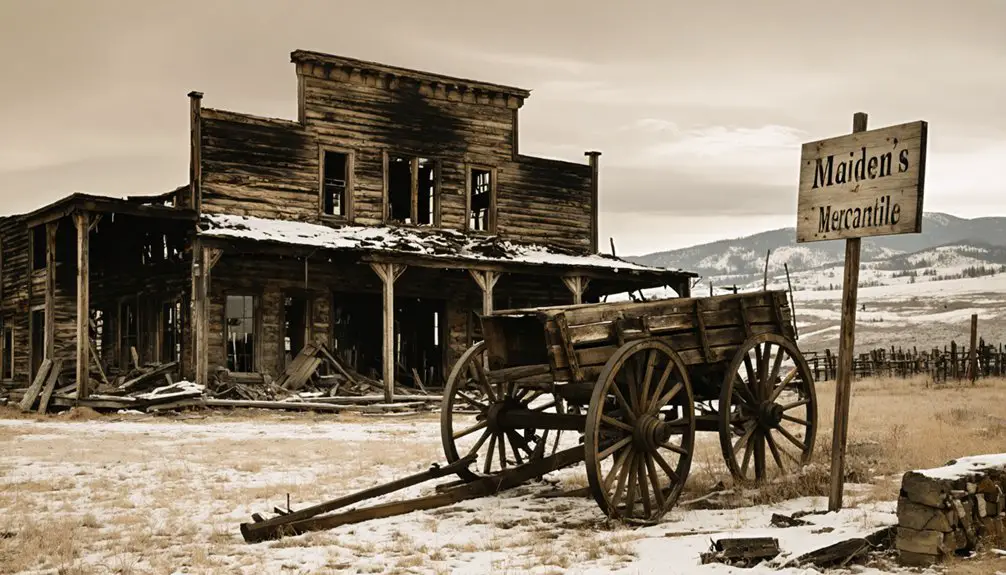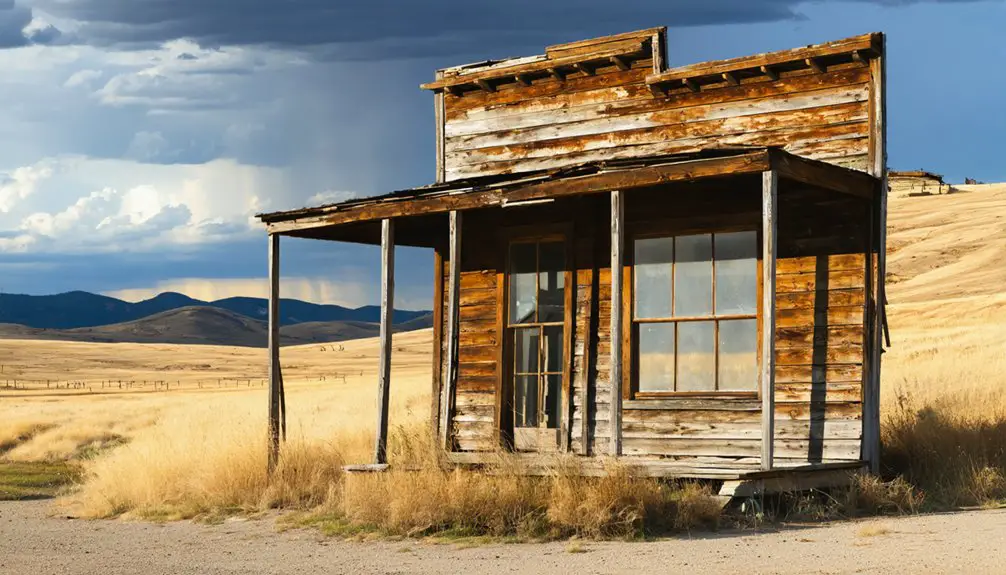You’ll find Maiden nestled in Montana’s Judith Mountains, where an 1881 gold discovery sparked a boom that drew 1,200 residents. The town quickly grew from tents to a bustling settlement with 13 saloons, hotels, and professional services. After producing over $5 million in gold through 1902, Maiden faced devastating setbacks – a catastrophic 1905 fire and mine failures. Today’s ghost town ruins tell a compelling story of Montana’s mining heritage that goes far deeper than its surface remains.
Key Takeaways
- Maiden was a thriving Montana gold mining town established in 1881, reaching a peak population of 1,200 during its prosperous years.
- The Spotted Horse mine was the town’s most successful operation, producing over $5 million in gold between 1881 and 1902.
- The town featured a bustling business district with 13 saloons, hotels, and professional services during its height in the 1880s.
- A devastating fire in 1905 accelerated Maiden’s decline, with the population dropping to fewer than 200 by 1896.
- The ghost town’s remains stand as a testament to Montana’s mining heritage, with the last saloon closing in 1918.
The Birth of a Mining Town
When gold was discovered in Montana’s Judith Mountains in April 1881, the town of Maiden sprang to life with remarkable speed.
Led by “Skookum Joe” Anderson and fellow prospectors, the initial mining techniques focused on placer gold before shifting to more profitable hardrock deposits.
Early miners under Skookum Joe Anderson first sought surface gold before pursuing deeper, more lucrative deposits in Montana’s rich terrain.
You’ll find that within just one year, the settlement transformed from a collection of tents into a bustling community of log and lumber houses.
The social dynamics of early Maiden reflected the raw spirit of the American frontier.
Without formal surveys or planning, newcomers simply staked their claims by marking and fencing lots.
By 1882, the population boom brought diverse businesses – from saloons and clothing stores to doctors and lawyers.
The Spotted Horse mine became the area’s most successful operation, producing over five million dollars in gold between 1881 and 1902.
The rush for riches attracted both independent prospectors and wealthy capitalists, creating a vibrant mix of fortune seekers.
The town reached its peak in 1886 when the population swelled to approximately 12,200 residents.
Origins Behind the Name
Like many 19th-century mining settlements, name theories often intertwined with personal connections and local lore.
The town received its name from Mrs. Conings’ daughter, establishing a familial connection to one of the area’s early residents.
The settlement was originally called Camp Maden after an early prospector in the area.
You’ll find historical connections to nearby mines with colorful names like Tom Thumb, War Eagle, and Spotted Horse, reflecting the era’s practice of naming places after acquaintances or distinctive characteristics.
Golden Years and Peak Prosperity

Maiden’s rise to prosperity began in 1881, transforming from a humble tent camp into a bustling mining settlement following the discovery of gold in the Judith Mountains. You’d have found a thriving community where social dynamics revolved around mining success and cultural influences from diverse settlers shaped daily life.
From tent camp to gold rush boomtown, Maiden emerged as a vibrant frontier settlement where mining fortunes shaped community life.
The town’s rapid growth brought impressive developments:
- A bustling business district with 13 saloons, hotels, and professional services
- Cultural amenities including a newspaper and cornet band
- Strong economic foundation with multiple mines, including the Maginnis operation that yielded nearly $2 million in gold
Fort Maginnis’s presence enhanced the town’s infrastructure, providing telegraph services and military protection. By 1883, the town had grown to include 154 buildings as mining operations expanded. At its peak, the mining town reached a population of 1,200 residents.
You’d have witnessed a spirited community competing for county seat status, reflecting Maiden’s prominence during its golden age.
Daily Life in 1880s Maiden
As settlers established themselves in the burgeoning mining town of 1881, daily life in Maiden centered around a mix of log structures and tent camps that gradually evolved into a more permanent community.
You’d find daily routines revolving around the harsh realities of mining work, with men descending into dangerous underground operations while women managed households and contributed to community building. Female schoolteachers were particularly vital to the town’s development, following the path of educators like Alma Coffin Kirkpatrick who taught in Montana during this era.
The Spotted Horse mine became a cornerstone of daily economic activity, yielding rich pockets of high-grade ore that drove the town’s prosperity.
Community gatherings took place in shared spaces where miners swapped stories after their shifts. You could visit the chapel for spiritual comfort, send telegrams at Fort Maginnis, or handle daily business at the post office.
Local shops, including the blacksmith and commissary, served your essential needs. Despite isolation and challenging conditions, you’d experience a tight-knit community where military personnel and civilians worked together to forge a new frontier life.
Military Tensions and Resolution
You’ll find that Maiden’s early development faced a serious challenge in 1883 when the U.S. Army ordered residents to abandon the town due to its location within Fort Maginnis‘s military reservation.
Historical records documenting this conflict can be found among the military-focused collections preserved in Montana’s archives today.
The settlers and miners protested this evacuation order, leading to negotiations with military authorities.
In a resolution that preserved the town’s future, the Army agreed to reduce Fort Maginnis’s boundaries, effectively removing Maiden from military jurisdiction and allowing civilian life to continue unimpeded.
Army Evacuation Order Controversy
During a period of heightened military activity in the region, the evacuation order controversy in Maiden created significant tension between military authorities and local residents.
You’ll find that evacuation challenges emerged when military communication failed to provide clear geographic boundaries and adequate notice to the townspeople. Similar to issues seen in international conflicts, residents received warnings through social media at night when many were asleep.
The primary concerns centered around three critical issues:
- Orders were issued with less than 30-minute notice, compromising residents’ ability to safely evacuate.
- Maps and geographic references provided by military authorities contained misleading information.
- No provisions were made for vulnerable populations with limited mobility.
The controversy highlighted the delicate balance between military necessity and civilian rights protection.
You’ll understand why many residents questioned the order’s legitimacy, especially given the lack of transparent communication and support for those unable to evacuate quickly.
Fort Maginnis Boundary Resolution
While tensions escalated between military and civilian interests near Maiden, the Fort Maginnis boundary dispute of 1880-1882 emerged as a critical test of territorial authority.
You’ll find that the U.S. Army’s claim over hay lands surrounding the fort directly challenged the DHS ranch’s operations under Granville Stuart’s management.
Military negotiations between the two parties stretched on for years, with the DHS ranch fighting to maintain its grazing rights while the Army sought to secure resources for its fort operations.
The land disputes finally reached resolution in May 1882 when the Army relinquished control of the contested hay lands back to DHS, marking a significant victory for civilian property rights.
This compromise allowed the ranch to resume its cattle operations while maintaining a cooperative relationship with Fort Maginnis.
Business and Commerce at Its Height
You’d find Maiden’s bustling commercial district in 1883 packed with eight saloons, clothing stores, general merchandise shops, and crucial services like a butcher shop and blacksmith.
The town’s merchants thrived on the steady flow of cash from independent prospectors and mining investors who poured thousands of dollars into local ventures, particularly the Collar Company Mine.
This economic vitality supported cultural amenities that enhanced business life, including a brass band and baseball team, making Maiden a complete frontier community rather than just a mining camp.
Diverse Merchant Scene 1883
As Maiden reached its commercial zenith in 1883, the bustling Montana boomtown boasted an impressive array of businesses that served its growing population of miners and settlers.
You’d find remarkable merchant diversity throughout the town’s 154 buildings, reflecting a maturing local economy that went far beyond basic mining needs.
The town’s commercial importance was evident in its varied establishments:
- Eight saloons and Louis Landt’s Brewery served the social scene.
- Five general merchandise stores plus specialized shops like blacksmiths and clothiers met daily needs.
- Professional services included a doctor’s office and S.C. Edgerton’s law practice.
Despite challenges from its unsurveyed layout and location within Fort Maginnis Military Reservation, Maiden’s merchants created a self-sufficient community that balanced mining, agriculture, and essential services.
Mining Money Drives Growth
The arrival of well-funded capitalists in 1881-1882 transformed Maiden’s mining district from a collection of independent claims into an industrialized operation.
You’d have seen massive mining investments pour into the area, particularly in the Collar Company Mine, which established central Montana’s first large amalgamation mill just northeast of town.
This surge of capital sparked rapid growth, and you could’ve found everything from saloons to doctor’s offices lining Maiden’s streets.
While the Collar Mine’s dramatic failure in 1883 triggered significant economic fluctuations, the town’s diverse commercial foundation helped buffer some impacts.
Despite setbacks and territorial disputes with Fort Maginnis, Maiden’s business scene thrived through the mid-1880s, fueled by the continuous flow of mining wealth from other successful operations.
The Great Fire of 1905

During the sweltering summer of 1905, fierce hurricane-force winds transformed small fires into an uncontrollable firestorm that devastated Maiden and much of Montana’s Northern Rockies.
The fire’s impact on the community was catastrophic, with flames soaring hundreds of feet high and entire mountainsides igniting simultaneously. You’d have witnessed daylight turn to darkness as thick smoke engulfed the region.
The extreme conditions created these terrifying phenomena:
- Trees became “exploding candles” with fire racing through their tops
- Firestorms jumped across wide canyons like “flying blowtorches”
- Smoke traveled as far as Greenland, darkening skies across the continent
Despite the devastating losses, the community’s resilience shone through. Many sought refuge in mine tunnels, including a group of 39 men saved by ranger Edward Pulaski’s quick thinking and bravery.
From Boom to Bust
Maiden’s remarkable rise from a simple townsite in 1881 to a bustling community of 154 buildings by 1883 showcased Montana’s dynamic mining frontier.
You’d have found a vibrant scene with eight saloons, various merchants, and essential services like doctors and lawyers serving the town’s growing population.
The community’s initial prosperity wouldn’t last, as the collapse of the Collar Mine in late 1883 and subsequent mining failures sparked a gradual economic decline that the devastating 1905 fire would later accelerate.
Mining Town’s Rapid Rise
After prospectors discovered gold in Montana’s Judith Mountains in 1880, an ambitious mining settlement called Maiden emerged virtually overnight, transforming from empty wilderness into a bustling boomtown by 1881.
Early gold discoveries by “Skookum Joe” Anderson and others sparked a rush of independent prospectors and investors who quickly established a thriving community.
The town’s explosive growth included:
- Multiple hardrock mining operations like the Maginnis, Spotted Horse, and Cumberland mines
- Over 154 buildings by 1883, including 13 saloons and the region’s first large amalgamation mill
- A peak population of 1,200 residents supported by commercial enterprises like the Belanger Department Store
You’d find everything from blacksmiths to doctors setting up shop, as Maiden’s prosperity attracted diverse businesses and services despite its frontier challenges.
Decline After 1905 Fire
A devastating fire in 1905 marked the beginning of Maiden’s final chapter as a thriving mining settlement. The blaze, sparked by a carelessly discarded cigarette behind a saloon, ravaged the business district and accelerated the town’s economic collapse.
You’ll find the community disintegration happened swiftly after the fire. With no insurance to cover her $80,000 loss, storekeeper Natalie Belanger’s tragedy exemplified the personal toll on residents.
The town’s essential services gradually disappeared – the last saloon closed in 1918, followed by the post office in 1921 and the school shortly after.
While nearby Lewistown prospered, Maiden’s population, already down from its 1880s peak of 1,200 to fewer than 200 by 1896, continued to dwindle. Without effort to rebuild, the once-bustling mining town faded into near abandonment.
What Remains Today

Today in Maiden, Montana, nearly 20 structures stand as silent witnesses to the town’s mining heritage, ranging from deteriorating ruins to renovated residences.
You’ll find the historic saloon/assay office and the privately preserved 1884 Maginnis ten stamp mill among the remaining structures. While most buildings sit on private property, you can explore visually from Montana and Main Street.
Key features you can observe from public roads include:
- Remodeled dwellings still serving as private homes
- The iconic saloon/assay office building
- The preserved ten stamp mill from Maiden’s mining heyday
Since the townsite rests entirely on private land, your exploration is limited to roadside viewing.
Signs scattered throughout provide historical context, helping you connect with Maiden’s once-thriving mining community while respecting private property boundaries.
Legacy in Montana’s Mining History
The remnants of Maiden stand as part of Montana’s rich mining heritage, which began taking shape in the 1850s when Hudson’s Bay Company traders first discovered gold near Deer Lodge.
Like many mining towns that followed, Maiden’s story reflects the economic fluctuations that defined Montana’s territorial growth, from its promising beginnings in 1881 to its eventual decline.
You’ll find Maiden’s legacy woven into Montana’s cultural heritage through its complex social dynamics, including the controversial expulsion of Chinese miners in 1886.
The town’s rise and fall mirrors the broader pattern of Montana’s mining districts, where local governance, stockholder disputes, and demographic shifts shaped community life.
Mining towns like Maiden captured Montana’s complex social fabric, where business interests and population changes determined a community’s destiny.
Today, Maiden serves as a monument to the transformative power of mining booms and their lasting impact on Montana’s political and social landscape.
Frequently Asked Questions
What Happened to the Residents of Maiden After the Town’s Decline?
You’ll find most residents moved to Lewistown for work, while others adapted to ranching nearby. Despite relocation stories suggesting complete abandonment, some families stayed, maintaining properties without the ghost sightings.
Were There Any Famous Outlaws or Notable Crimes in Maiden?
You won’t find famous outlaws or notable crimes in Maiden’s history books. Unlike nearby Rocky Point’s rustler troubles, this mining town maintained relative peace despite its boom-era population of 1,200.
What Was the Average Gold Yield From Maiden’s Mines?
You won’t find reliable records of Maiden’s average gold yield, as mining technology and gold extraction data weren’t well documented. It’s likely yields were modest compared to Montana’s major mining districts.
Did Any Native American Tribes Interact With the Maiden Settlement?
While records show 13 tribal nations in Montana, you’ll find limited documented interactions between Native tribes and Maiden’s settlers, though cultural exchange likely occurred through trade in the region.
What Was the Typical Wage for Miners Working in Maiden?
You’d have earned around $3.00-$3.50 per day as a Maiden miner in the early 1900s, though mining wages fluctuated based on economic impact and labor disputes between workers and mine owners.
References
- https://westernmininghistory.com/towns/montana/maiden/
- https://digging-history.com/2014/06/18/ghost-town-wednesday-maiden-montana/
- https://www.montanaliving.com/blogs/destinations/explore-montana-ghost-towns
- https://www.montanahikes.com/judith-mountains-and-their-ghost-towns/
- https://www.youtube.com/watch?v=uudX-dDQ1_E
- https://centralmontana.com/blog/ghost-towns-gold-mines-in-central-montana/
- https://www.ghosttowns.com/states/mt/maiden.html
- https://en.wikipedia.org/wiki/Rocky_Point
- https://montanawomenshistory.org/research/bibliographies/manuscript-bibliography-of-montanas-19th-century-women/
- https://www.mtmemory.org/nodes/view/3971



